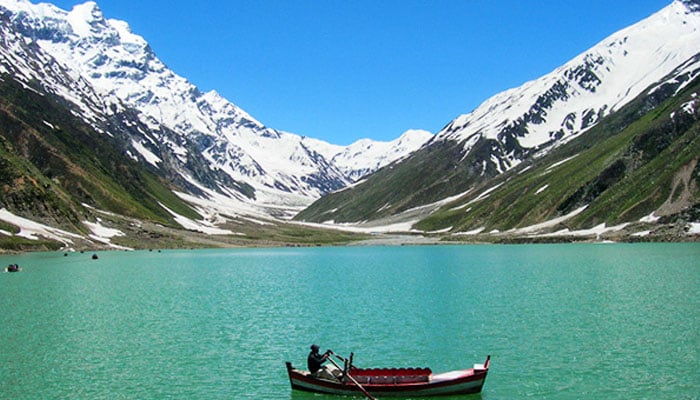ISLAMABAD: Growing average temperatures in Pakistan’s north, have increased the melting pace of glaciers, said Mohammad Saleem, spokesperson for Climate Change Ministry and environmental educationist.
He said, “This may lead to initially a heightened water flow in the Indus river and its various tributaries, located in Gilgit-Baltistan region and Khyber-Pakhtunkhwa province and then follow the depleted flows."
While the glacial-fed 3,180-km long Indus river, one of the longest rivers in Asia, supports biodiversity, ecosystems of temperate forests and food systems in the country, its sustained flows are vital to the country’s socio-economic, environmental and ecological sustainability.
Talking to APP in an exclusive interview, the official said that the country’s northern region is home to over 5,000 glaciers.
But many of them are melting at a much faster rate because of soaring average temperatures in the mountainous valleys.
“Presently, the glacial melt is among major global warming-caused risk Pakistan is faced with.
Other risks include sea-level rise, floods, higher than average temperature, a higher frequency of droughts and expanding desertification,” the Climate Change spokesperson told APP during the interview.
He further said that Pakistan’s weather scientists have already shown through findings of their various scientific studies based on satellite imagery and field-based studies that there is strong evidence that glaciers in Karakoram mountain range in upper Indus Basin are melting at a higher pace.
“The rising temperatures in snow-covered areas in Gilgit-Baltistan and Chitral district are causing mountain streams and rivers swell alarmingly in summer months and burst their banks.
Resultantly, this is causing flooding and damages to community infrastructures,” he explained.
Another big environmental tragedy the country is facing in recent years is the significant decline in snowfall season and quantum of snowfall.
“The country’s northern regions used to receive snowfall from October to February and in some cases as late as March.
But, what we observed and heard the mountain communities saying during our field visit two years ago is that snow falls during January and February that too in low quantity,” he observed.
He highlighted that low snow accumulation and spiking warming temperatures are also causing snowline to recede in the glacier areas, particularly in Karakoram mountain range.
Quoting findings of the studies of the Pakistan Meteorological Department, he said, “Over last more than 30 years the snow line has receded by over 1.1 kilometres.
Apart from it, uphill migration of animals and plants has been observed that are clear indicator that glaciers are shrinking.”
He told APP that the findings based on glacier monitoring station at the Passu glacier (having ice reserves of nearly 10.89 cubic km) near Gojal vallly in Gilgit-Baltistan, has showed that the glacier has retreated by 25 metres in last one year.
He said that even during peak summer months, temperature never used to go beyond 28 Celsius in most of the mountain valleys in the country’s northern region.
But for the last nearly eight years, these mountain valleys are in grip of spiking summer temperatures that rose up to 46 Celsius.
The rising temperatures have also affected precipitation patterns in these areas, he told APP.
“What we heard from the communities there in mountain valleys was that rain falls in the month of snowfalls.Besides, snow hardly falls only on mountain peaks while sloppy grounds in mountain areas either do not receive snowfall or receive in low quality. However, rainy spells are replacing snowfall spells in the areas like Hunza, Skardu, Chitral, Gojal, Phander, Ghizer, Gulmit, etc,” the spokesperson elaborated.
He suggested that paced up glacial melt and decline in snowfalls quantum and duration, forewarn a scary water availability scenario for the country.
“Pakistan is caught into a quagmire of rapidly shirking water availability for agriculture, household and industrial needs and has already suffered more than five-fold decline in per capita water availability over last around 86 years,” the official said.
The Climate Change Ministry Spokesperson suggested that building more water reservoirs, adopting low-carbon energy sources such as solar, wind, hydro, promoting rainwater harvesting and groundwater recharging systems, enhancing efficient water management and use, particularly in agriculture sector, which accounts for 94-96percent of the water use and boosting public awareness about water conservation can help the country survive socio-economic and environmental repercussions of depleting water resources.
-
Security forces gun down 30 terrorists in multiple IBOs in KP: ISPR
-
MQM-P calls for new province in Sindh
-
US report validates Pakistan military edge over India: PM
-
Banned TTP poses serious threat to Pakistan security: UNSC panel
-
CM Afridi clarifies remarks on by-poll after ECP requests army deployment
-
Dubai sees 3.2m Pakistani passengers in 2025 as airport sets new milestone
-
Security forces kill 23 Indian proxy terrorists in KP's Kurram
-
Pakistan to construct island to boost oil exploration: report












